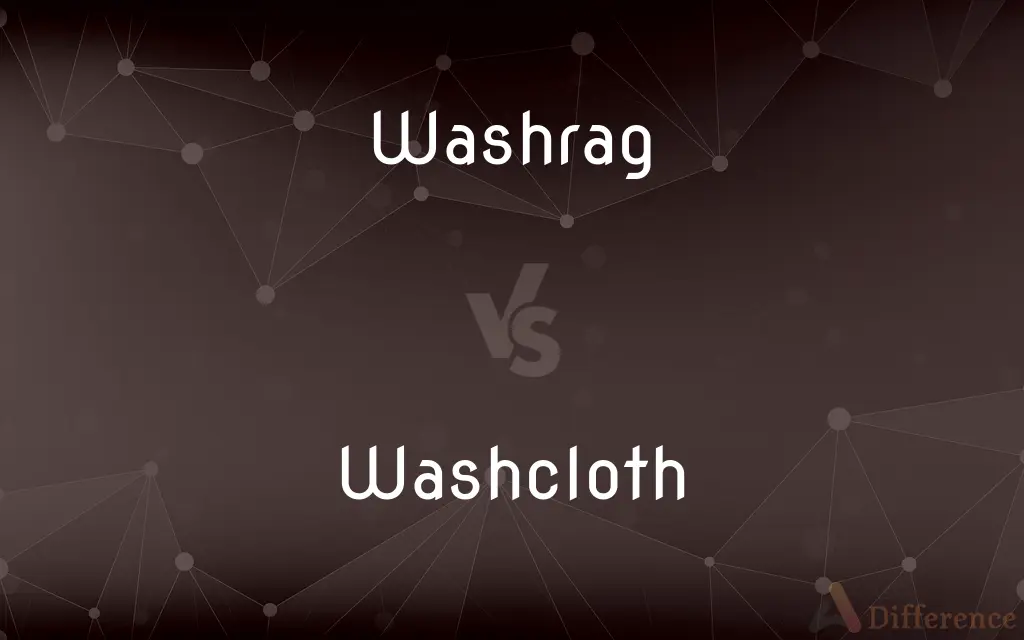Washrag vs. Washcloth — What's the Difference?
Edited by Tayyaba Rehman — By Fiza Rafique — Updated on April 21, 2024
A washrag typically refers to any small rag used for washing, often improvised, while a washcloth is a specific, typically square piece of cloth designed for personal hygiene.

Difference Between Washrag and Washcloth
Table of Contents
ADVERTISEMENT
Key Differences
A washrag is generally a casual term that might refer to any small piece of cloth used for cleaning, which could be made from old clothing or towels. On the other hand, a washcloth is a pre-made, often square piece of soft fabric specifically manufactured for washing the body or face.
The texture and material of a washrag can vary widely, depending on what is available, which might not always be soft or ideal for delicate surfaces. Whereas, washcloths are usually made from soft materials like cotton or terry cloth, making them suitable for sensitive skin.
Washrags can be used for a variety of cleaning tasks, not limited to personal care, such as cleaning spills or dusting surfaces. Conversely, washcloths are primarily intended for personal hygiene, used in bathrooms and during bathing.
The durability and maintenance of a washrag depend on its material, and it may not last as long as a washcloth, which is designed to withstand repeated wetting and drying cycles in bathroom environments.
While washrags can be more economical and environmentally friendly, as they often repurpose old fabric, washcloths offer a uniform, aesthetic appeal and are commonly sold in matching bathroom sets.
ADVERTISEMENT
Comparison Chart
Definition
Any small cloth used for cleaning
A small, soft cloth for washing
Typical Usage
General cleaning or personal care
Specifically for personal hygiene
Material
Varies (cotton, linen, old clothes)
Usually soft materials like cotton
Durability
Depends on material
High, designed for frequent use
Design
Often improvised or repurposed
Specifically manufactured
Compare with Definitions
Washrag
A small piece of fabric used for cleaning.
She grabbed a washrag to mop up the spilled coffee.
Washcloth
Specifically designed for washing the body and face.
She used a fresh washcloth every day during her skincare routine.
Washrag
An improvised cleaning cloth made from an old garment.
He used an old t-shirt as a washrag for his car.
Washcloth
A bathroom essential made from soft fabric.
His washcloth matched the color of his bathroom towels.
Washrag
A versatile cloth that can be used in various cleaning scenarios.
She keeps a washrag in her kitchen for quick clean-ups.
Washcloth
Used for gentle cleaning of sensitive areas.
He used a soft washcloth on the baby’s skin during bath time.
Washrag
Any cloth used for general cleaning purposes.
The washrag in the workshop is great for wiping grease off tools.
Washcloth
A small, square cloth for personal hygiene.
She packed a washcloth for her trip to ensure she could wash her face.
Washrag
A temporary solution for cleaning needs.
They used a washrag until they could buy more cleaning supplies.
Washcloth
Part of a set of bath linens in many homes.
The new washcloths were part of a luxurious bath set gift.
Washrag
See washcloth.
Washcloth
A small, usually square cloth of absorbent material used for washing the face or body. Also called facecloth, washrag.
Washrag
(Southern US) A square piece of cloth for washing the face and body.
Washcloth
A small cloth used to wash the face and body.
Washrag
Bath linen consisting of a piece of cloth used to wash the face and body
Washcloth
Bath linen consisting of a piece of cloth used to wash the face and body
Common Curiosities
How often should I replace my washcloth?
It is recommended to replace or wash your washcloth frequently to maintain hygiene, typically after a few uses.
What is a washrag used for?
A washrag can be used for various cleaning tasks around the house, including personal care.
How do I care for my washcloth to keep it hygienic?
Wash your washcloth regularly in hot water with detergent, and allow it to dry completely between uses to prevent the growth of bacteria and mold.
Can I use a washrag on my face?
It depends on the material; washcloths are generally softer and more suitable for delicate facial skin.
What materials are washcloths made from?
Washcloths are often made from soft materials like cotton or terry cloth for gentle cleaning.
Can I use a washcloth for cleaning tasks other than bathing?
While it’s possible, washcloths are best reserved for personal care to avoid the transfer of harsh chemicals or contaminants to your skin.
Are washrags environmentally friendly?
Yes, washrags can be environmentally friendly as they often repurpose old textiles, reducing waste and extending the life of fabrics.
What sizes do washcloths come in?
Washcloths typically come in a standard size, about 12 by 12 inches, ideal for hand use and convenient for personal hygiene tasks.
Is a washcloth the same as a washrag?
No, a washcloth is specifically designed for personal hygiene, while a washrag may refer to any small cloth used for cleaning.
What are the benefits of using a washcloth over a washrag?
Washcloths are specifically designed for skin contact, making them softer and more suitable for face and body use, ensuring gentle and effective cleaning.
Can using a washcloth help improve my skin health?
Yes, using a washcloth can help exfoliate the skin, removing dead skin cells and promoting clearer, healthier skin when used properly.
How often should I replace my washrag?
Replace your washrag whenever it shows signs of wear or becomes too soiled, as its effectiveness and hygiene can diminish with prolonged use.
What is the best material for a washcloth if I have sensitive skin?
For sensitive skin, choose a washcloth made of 100% cotton or microfiber, as these materials are soft and less likely to irritate the skin.
Is it more cost-effective to use washrags or washcloths?
Washrags can be more cost-effective as they repurpose existing fabrics, but washcloths may offer better value in the long run due to their durability and specific design for personal care.
Share Your Discovery

Previous Comparison
Soup vs. Chowder
Next Comparison
Delegate vs. DelegateeAuthor Spotlight
Written by
Fiza RafiqueFiza Rafique is a skilled content writer at AskDifference.com, where she meticulously refines and enhances written pieces. Drawing from her vast editorial expertise, Fiza ensures clarity, accuracy, and precision in every article. Passionate about language, she continually seeks to elevate the quality of content for readers worldwide.
Edited by
Tayyaba RehmanTayyaba Rehman is a distinguished writer, currently serving as a primary contributor to askdifference.com. As a researcher in semantics and etymology, Tayyaba's passion for the complexity of languages and their distinctions has found a perfect home on the platform. Tayyaba delves into the intricacies of language, distinguishing between commonly confused words and phrases, thereby providing clarity for readers worldwide.














































